The New York State Senate Standing Committees on Agriculture, Labor, and Social Services recently held a hearing titled, “Diversifying Agriculture and Addressing Food Justice Alongside Continuing Inequalities in our Food Systems.” NYHealth submitted the following written testimony sharing new data on food scarcity, along with recommendations for improving food security in New York State:
April 7, 2021
Distinguished members of the Senate Standing Committee on Agriculture, Standing Committee on Labor, and Standing Committee on Social Services:
The New York Health Foundation (NYHealth) appreciates the opportunity to submit written testimony on the topic of increasing food security and equity in New York State. NYHealth is a private, independent foundation that works to improve the health of all New Yorkers, especially the most vulnerable. Our work has provided us with in-depth knowledge of food insecurity’s widespread ramifications for the health of children, families, and the communities they live in. In particular, our Healthy Food, Healthy Lives program supports expanding access to nutritious, affordable foods.[1]
Since 2014, we have invested millions of dollars to improve food security across New York State. NYHealth has supported the creation of more than 85 new healthy food access points like farmers markets, mobile markets, and grocery and corner stores; supported the establishment of regional food hubs in New York City and the North Country; and expanded access to and demand for nutritious, affordable foods, including nutrition incentive programs that encourage Supplemental Nutrition Assistance Program (SNAP) use. NYHealth’s investments also helped secure universal free school lunch for New York City’s 1.1 million public school children.
As part of our Healthy Food, Healthy Lives funding area, NYHealth is supporting organizations that build the capacity of farmers of color. According to the USDA’s agricultural census, New York State has 57,865 farmers, of whom only 204 identify as Black or African American (total non-white: 976).[2] By and large, these farms are small and lack the infrastructure and longstanding institutional relationships that are necessary to compete in the institutional marketplace. The New York City Good Food Purchasing Program Coalition is convening farmers of color across the State to document the challenges they face—including barriers to accessing institutional markets—and providing technical assistance to help them build their capacity to compete in larger markets. Black Farmers United NYS is supporting farmers of color and food system entrepreneurs to fill the gaps in the food system by providing a wider range of options outside of food banks, discount grocery stores, and corner stores, and increasing the presence of fresh produce in Black communities.
NYHealth also collaborates with New York State’s Departments of Health and Agriculture and Markets on efforts to improve food security. Members of our staff sit on the New York State Council on Hunger and Food Policy workgroup. We applaud the State’s continued recognition of and focus on the role that access to healthy food plays in maintaining good health and preventing disease, especially in response to COVID-19. The State has worked rapidly to launch new initiatives to ensure that New Yorkers have access to food.
New Data on New Yorkers’ Food Scarcity During COVID-19
NYHealth has analyzed new data that shed light on the growing and stark food security challenges facing New Yorkers. This analysis can support the State in its continued efforts to design programs and target resources.
The data presented here are from an NYHealth analysis based on the COVID-19 Household Pulse Survey, which was administered by the U.S. Census Bureau in collaboration with multiple federal agencies. The survey provided near real-time data on household experiences, including with food scarcity, from April 23, 2020, until March 29, 2021. Further information about the survey is available on the Census Bureau website.[3] Below are key findings from the NYHealth analysis for New York State for the months of May–December 2020:
- In December 2020, 14% of adult New Yorkers reported that there was either sometimes or often not enough to eat in their household in the last 7 days (defined here as household food scarcity) (see Figure 1). This is an increase from May 2020, when 10% of adult New Yorkers reported household food scarcity.
- New York State’s food scarcity rate was higher than those reported in neighboring states and the national average for nearly every month (see Figure 2).
- In December 2020, 19% of households with children reported that the children were often or sometimes not eating enough in the prior week, because the household could not afford enough food (see Figure 3).
- There are stark disparities in food scarcity by race and ethnicity. In December 2020, nearly 1 in 3 Hispanic New Yorkers (32%) and more than 1 in 5 Black New Yorkers (21%) reported household food scarcity in the last 7 days (see Figure 4). These percentages were 2–3.5 times higher than among white New Yorkers.
- More New Yorkers are slipping from food security into food scarcity. In May 2020, nearly one-quarter of adults in households with food scarcity reported being food sufficient prior to the pandemic, but by December 2020, that figure had risen to more than one-third of respondents.
- Mass losses in employment have likely contributed to increases in food scarcity. Throughout the survey period, more than half of New Yorkers reported that they or someone in their household had lost employment income since the start of the pandemic. The rate of food scarcity was nearly four times higher for those who reported lost household employment income during the pandemic, compared with those who did not (in December 2020, 23% compared with 6%) (see Figure 5).
- Throughout the survey period, nearly 1 in 10 New Yorkers reported that their households were accessing free meals or groceries. In most months, school programs were the most-used access points (see Figure 6).
- When asked which sources they were using to meet household spending needs in the last week, food-scarce New Yorkers most frequently responded that they borrowed from family and friends, used credit cards or loans, or spent their savings or sold assets (see Figure 7).
NYHealth is available to discuss performing additional analyses that may be helpful to the Committees. The full analysis is available here:
New York Health Foundation. “One Year Later: Food Scarcity in New York State During the COVID-19 Pandemic,” March 3, 2021. https://nyhealthfoundation.org/resource/one-year-later-food-scarcity-in-new-york-state-during-the-covid-19-pandemic/.
Moving Forward
The COVID-19 pandemic has upended almost every aspect of New York State’s food system and worsened a food scarcity crisis that disproportionately affects New Yorkers of color. We offer the following recommendations to improve food security and build the food system back better:
1. Expand policy solutions that make it easier and more convenient for New Yorkers to access food, including:
- Implement cross-program outreach, eligibility determination, and enrollment through one statewide, online application for means-tested programs like SNAP, WIC, TANF, school meals, and Medicaid so New Yorkers can be connected through a single door to all the programs for which they are eligible.
- Streamline the process for schools and community-based organizations to participate in child nutrition programs (e.g., eliminate State-specific documentation and recordkeeping requirements that are not required by federal regulation).
- Establish a statewide universal school lunch program that would allow all of New York’s children to eat lunch regardless of income and without fear of shame or stigma, expanding upon New York City’s success. In the short term, this could be achieved by advocating for the extension of the U.S. Department of Agriculture’s (USDA) Summer Food Service Program and Seamless Summer Option waiver, set to expire September 30, 2021.[4] In the longer term, increasing the number of schools implementing the Community Eligibility Provision and improving New York State’s direct certification matching process would also expand access to school meals.
- Support public education campaigns that increase awareness of and enrollment in the WIC program, using trusted messengers.
- Reduce barriers to the use of—and invest more in—nutrition incentives such as New York City’s Health Bucks, Get the Good Stuff, New York State’s FreshConnect, and Double Up Food Bucks, which can increase the value of federal food benefits such as SNAP. Make these incentives available for use in more locations, including supermarkets, where people do the majority of their shopping.
- Support the creation of regional food plans to better understand and strengthen our food systems.
2. Maximize currently available flexibility in nutrition benefits programs, including SNAP and WIC.
- The State should continue to pursue all flexibilities offered by USDA, including extended re-certification timelines for benefits and removal of barriers to enrollment (e.g., in-person office visits).
- At the end of last year, the Governor signed a bill expanding the SNAP online purchasing pilot.[5] Early results from the pilot program showed that adoption of online grocery shopping has the potential to improve healthy food access for low-income consumers.[6] New York State should study the online SNAP program, identify barriers, and advocate to USDA to make it easier for New York State vendors to participate in the program.
- New York State is awaiting approval from USDA to operate the Pandemic EBT (P-EBT) program during the 2020–2021 school year.[7] The State should support the Office of Temporary and Disability Assistance to streamline the process of getting P-EBT funds to the people who need them more quickly.
- Federal legislation has increased SNAP benefits over the course of the pandemic. The Families First Act allows New York to issue supplementary SNAP benefits to households to bring them up to the maximum amount their household size is eligible to receive.[8] The American Rescue Plan Act recently extended the 15% increase to SNAP benefits until June 30, 2021.[9] A January executive order by President Biden also directs USDA to revise the formula used to determine SNAP benefits to better align benefits with the cost of food today.[10] The State should consider advocating for making increases to SNAP benefits permanent, which would have lasting benefits to food-insecure New Yorkers.
3. Invest in a more diverse agricultural system that better feeds New York’s diverse population.
New York State can support smaller, non-corporate producers and BIPOC farmers by increasing funding to the Farm to School Program and Nourish NY. Urban farms (such as the Farms at NYC Housing Authority) that create pipelines of new BIPOC farmers and bring fresh foods to communities that have historically faced barriers to food access should also be supported. Public institutions’ purchasing power can also be leveraged to promote a more diverse agricultural system through programs like the Good Food Purchasing Program.
NYHealth is grateful for the shared recognition among stakeholders of the need to increase food security and equity in New York State. We look forward to continuing our partnerships with the State and other organizations to connect New Yorkers with the foods they need to thrive.
Appendix
Figure 1. Food Scarcity in New York State
Percentage of adults in households where there was either sometimes or often not enough to eat in the last 7 days.
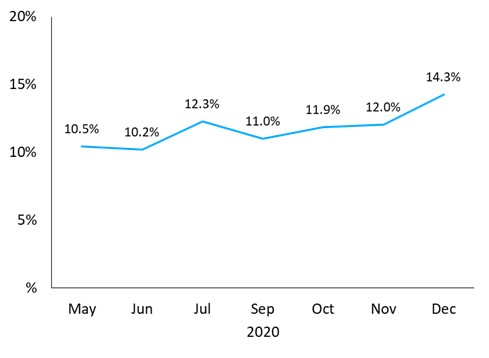
Note: Adults who responded to food scarcity question are included in the denominator. Rates are calculated across a month-long period using multiple weeks of data. Month of August is not shown due to gap between survey periods. See full report for methodology.
Figure 2. Food Scarcity by State
Percentage of adults in households where there was either sometimes or often not enough to eat in the last 7 days.
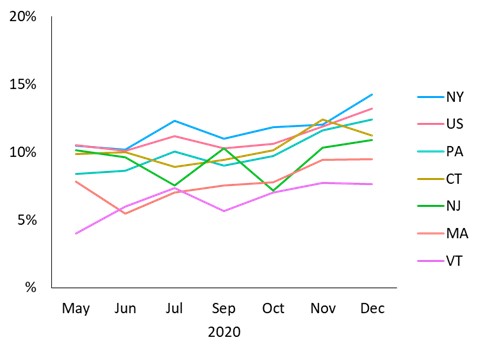
Note: Adults in each geographic area who responded to food scarcity question are included in the denominator. Rates are calculated across a month-long period using multiple weeks of data. Month of August is not shown due to gap between survey periods. See full report for methodology.
Figure 3. Child Food Scarcity in New York State
Percentage of adults in households with children where children were often or sometimes not eating enough in last 7 days because household could not afford enough food.
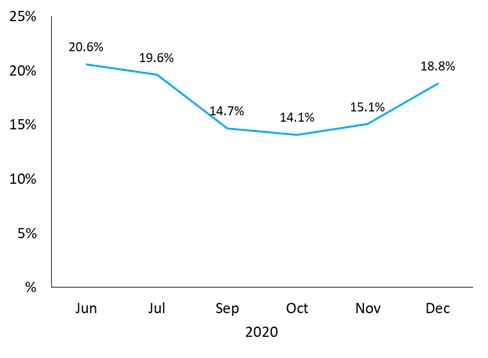
Note: Adults with children in household who responded to household food scarcity question are included in the denominator. Adults with children in household who reported child food scarcity are included in the numerator. Rates are calculated across a month-long period using multiple weeks of data. Child food scarcity question was introduced in week 6 of survey so month of May is not shown. Month of August is not shown due to gap between survey periods. See full report for methodology.
Figure 4. Food Scarcity in New York State, by Race/Ethnicity
Percentage of adults in households where there was either sometimes or often not enough to eat in the last 7 days.
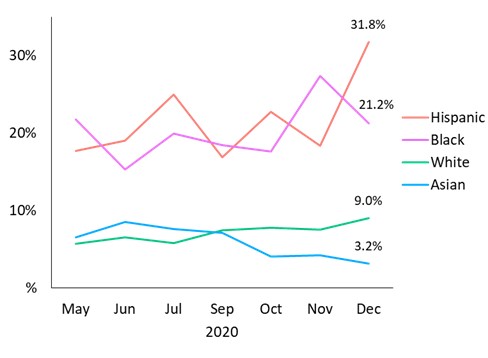
Note: Adults in each respective race/ethnicity category who responded to food scarcity question are included in the denominator. Rates are calculated across a month-long period using multiple weeks of data. Month of August is not shown due to gap between survey periods. See full report for methodology.
Figure 5. Food Scarcity in New York State, by Household Employment Income Loss
Percentage of adults that lost/did not lose household employment income (HEI) since March 13, 2020 that reported household food scarcity in last 7 days.
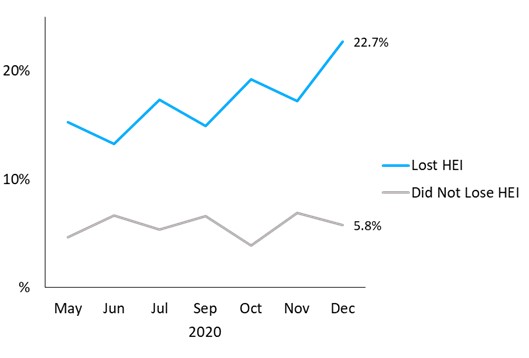
Note: Adults who reported that they did/did not experience a household employment income loss since March 13, 2020 and also responded to food scarcity question are included in the denominator. Rates are calculated across a month-long period using multiple weeks of data. Month of August is not shown due to gap between survey periods. See full report for methodology.
Figure 6. Free Food Access Points
Percentage of adults in households that accessed free meals or groceries in last 7 days that used a particular food access point (categories not exclusive).
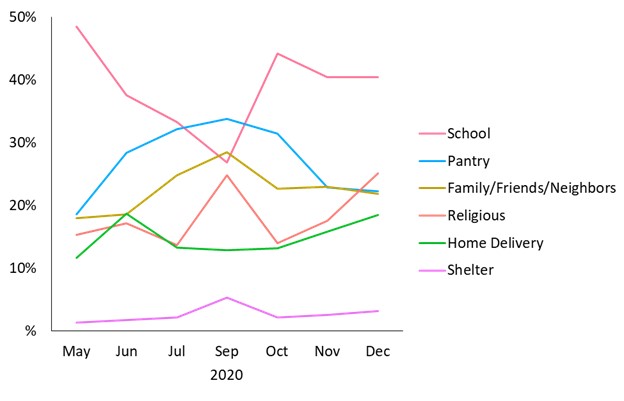
Note: Adults who responded that their household accessed a free meal or groceries in the last 7 days and selected at least one free food access point are included in the denominator. Respondents could select multiple answers for where they or someone in their household accessed a free meal or groceries. Not all access sites are included due to low counts. Some school programs offered free meals via delivery, so some home delivery responses might be part of school program. Responses for shelters may be artificially low, because the populations that most use shelters may have been less likely to have had access to a cellphone or email to be part of survey sample. Rates are calculated across a month-long period using multiple weeks of data. Month of August is not shown due to gap between survey periods. See full report for methodology.
Figure 7. Household Spending Sources (Dec 2020)
Percentage of adults responding that they or a member of their household used the following sources to meet spending needs in last 7 days (categories not exclusive).
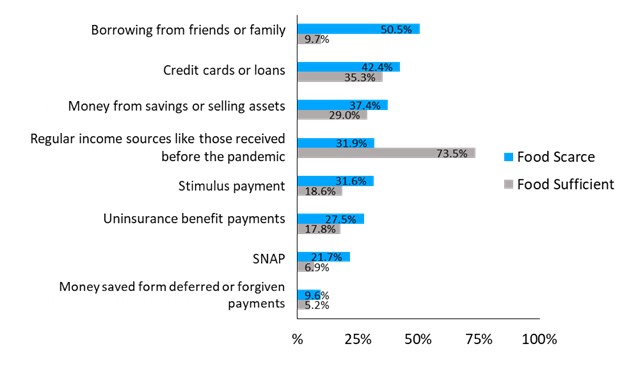
Note: For rates among the food scarce, adults who reported household food scarcity in the last 7 days and selected at least one spending source are included in the denominator. For rates among the food sufficient, adults who reported household food sufficiency in the last 7 days and selected at least one spending source are included in the denominator. Food sufficiency is defined as a household having enough of the kinds of food wanted, or having enough food, but not always the kind wanted, in the prior 7 days. Respondents could select multiple sources. Rates are calculated across a month-long period using multiple weeks of data. See full report for methodology.
[1] New York Health Foundation, “Healthy Food, Healthy Lives,” https://nyhealthfoundation.org/what-we-fund/healthy-food-healthy-lives/.
[2] 204 producers identify as Black or African American alone or in combination with other races. See United States Department of Agriculture, “2017 Census of Agriculture. State Level Data: New York. Table 63. Selected Producer Characteristics by Race: 2017,” 2017, https://www.nass.usda.gov/Publications/AgCensus/2017/Full_Report/Volume_1,_Chapter_1_State_Level/New_York/st36_1_0063_0063.pdf.
[3] U.S. Census Bureau, “Measuring Household Experiences during the Coronavirus Pandemic,” April 2021, https://www.census.gov/householdpulsedata.
[4] United States Department of Agriculture Food and Nutrition Service, “Child Nutrition Waiver Update,” March 9, 2021, https://www.fns.usda.gov/cn/covid-19-child-nutrition-response-73.
[5] S. 8247A, 2019-2020 Leg., Reg. Sess. (N.Y. 2020).
[6] Isabelle Foster et al., “Understanding Nationwide Uptake: An Analysis of the Newly Expanded SNAP Online Purchasing Program during 2020” (unBox, February 10, 2021), https://www.unboxproject.org/snap-online-purchasing-brief.
[7] New York State Office of Temporary and Disability Assistance. “P-EBT Frequently Asked Questions,” December 9, 2020. http://otda.ny.gov/SNAP-COVID-19/Frequently-Asked-Questions-Pandemic-EBT.asp.
[8] United States Department of Agriculture Food and Nutrition Service, “SNAP Emergency Allotments – Guidance,” April 1, 2021, https://www.fns.usda.gov/snap/emergency-allotments-guidance-040121.
[9] United States Department of Agriculture Food and Nutrition Service, “Supplemental Nutrition Assistance Program (SNAP) – SNAP Provisions in the American Rescue Plan Act of 2021,” March 12, 2021, https://fns-prod.azureedge.net/sites/default/files/media/file/signed%20SNAP-AmericanRescuePlanAct2021.pdf.
[10] White House Briefing Room, “Fact Sheet: President Biden’s New Executive Actions Deliver Economic Relief for American Families and Businesses Amid the COVID-19 Crises,” January 22, 2021, https://www.whitehouse.gov/briefing-room/statements-releases/2021/01/22/fact-sheet-president-bidens-new-executive-actions-deliver-economic-relief-for-american-families-and-businesses-amid-the-covid-19-crises/.

